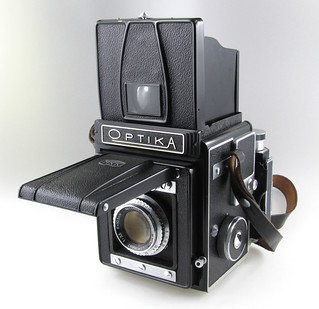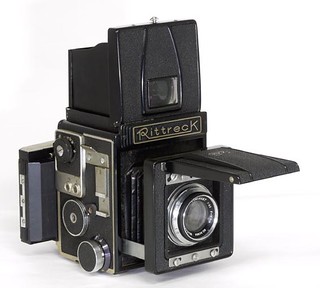Rittreck (6×9)

|
| US export version, branded Optika image by S. Katz (Image rights) |
The Rittreck is a 6×9cm SLR without a revolving back, made from 1955 by Musashino Kōki. The most common versions are the Rittreck IIA and Rittreck SP. The Optika IIA was a name variant of the Rittreck IIA, sold by Seymour's, a distributor based in New York. The camera is a modern, metal-bodied version of the wooden-bodied SLR cameras of the early 20th century, like the Soho Reflex. It has rack-and-pinion focusing and a cloth focal-plane shutter.
The standard lens is Musashino's own 105mm f/3.5 Luminon or Luminant. A 90mm lens is the shortest that can be fitted, because of the rigid body. Advertising for the camera noted that, because lenses fit with interchangeable lens boards as in a large-format camera, the user's own lenses can be used, whether shuttered or not.
The roll film holder allows several formats (8, 1, 12 or 16 exposures on a 120 roll) by the use of removable masks.
Bibliography
- Asahi Camera (アサヒカメラ) editorial staff. Shōwa 10–40nen kōkoku ni miru kokusan kamera no rekishi (昭和10–40年広告にみる国産カメラの歴史, Japanese camera history as seen in advertisements, 1935–1965). Tokyo: Asahi Shinbunsha, 1994. ISBN 4-02-330312-7. Items 1017 and 1807–9. (See also the advertisement for item 1810.)
- Kamera no ayumi. Zen nihon shashin renmei sōritsu 50-shūnen kinen (カメラのあゆみ・全日本写真連盟創立五〇周年記念, History of cameras, commemorating the 50th anniversary of the All Japan Association of Photographic Societies). Tokyo: Asahi Shinbunsha, 1976. No ISBN number. P.104.
- Lewis, Gordon, ed. The History of the Japanese Camera. Rochester, N.Y.: George Eastman House, International Museum of Photography & Film, 1991. ISBN 0-935398-17-1 (paper), 0-935398-16-3 (hard). P.94.
- McKeown, James M. and Joan C. McKeown's Price Guide to Antique and Classic Cameras, 12th Edition, 2005-2006. USA, Centennial Photo Service, 2004. ISBN 0-931838-40-1 (hardcover). ISBN 0-931838-41-X (softcover). P.705.
- Sugiyama, Kōichi (杉山浩一); Naoi, Hiroaki (直井浩明); Bullock, John R. The Collector's Guide to Japanese Cameras. 国産カメラ図鑑 (Kokusan kamera zukan). Tokyo: Asahi Sonorama, 1985. ISBN 4-257-03187-5. Items 2249–50.
Links
In English:
- Rittreck IIa profiled at Shutterbug.com
- Rittreck IIA and Rittreck SP at Takasaki Motohiro's camera site, with a reproduction of a brochure and user manual for the Optika IIA
- Rittreck IIA at artbig.com by Sébastien Lallement
- Rittreck IIA serial no. 2537, with 105 mm f/3.5 Luminon, sold at the fifteenth Westlicht Photographica Auction (May 2009).
- Rittreck IIA serial no. 8673, with 90 mm f/3.5 Luminon, 105 mm f/3.5 Luminant and 210 mm f/4.5 Luminant, sold at the ninth Westlicht auction (May 2006).
- Tele-Luminant 40 cm f/5.6 serial no. 41827, also sold at the ninth Westlicht auction.
- Rittreck PS PDF manual at Butkus' OrphanCameras.com
In Japanese:
- Rembrandt prototype (Rittreck's predecessor) at Shashinki to Tōgei
- Rittreck IIA repair notes at Takasaki Motohiro's camera site
- Rittreck IIA repair notes at Kan's Room
- Rittreck IIA at Asacame

|
| A full kit of the Optika export name variant image by Michael Roth (Image rights) |
